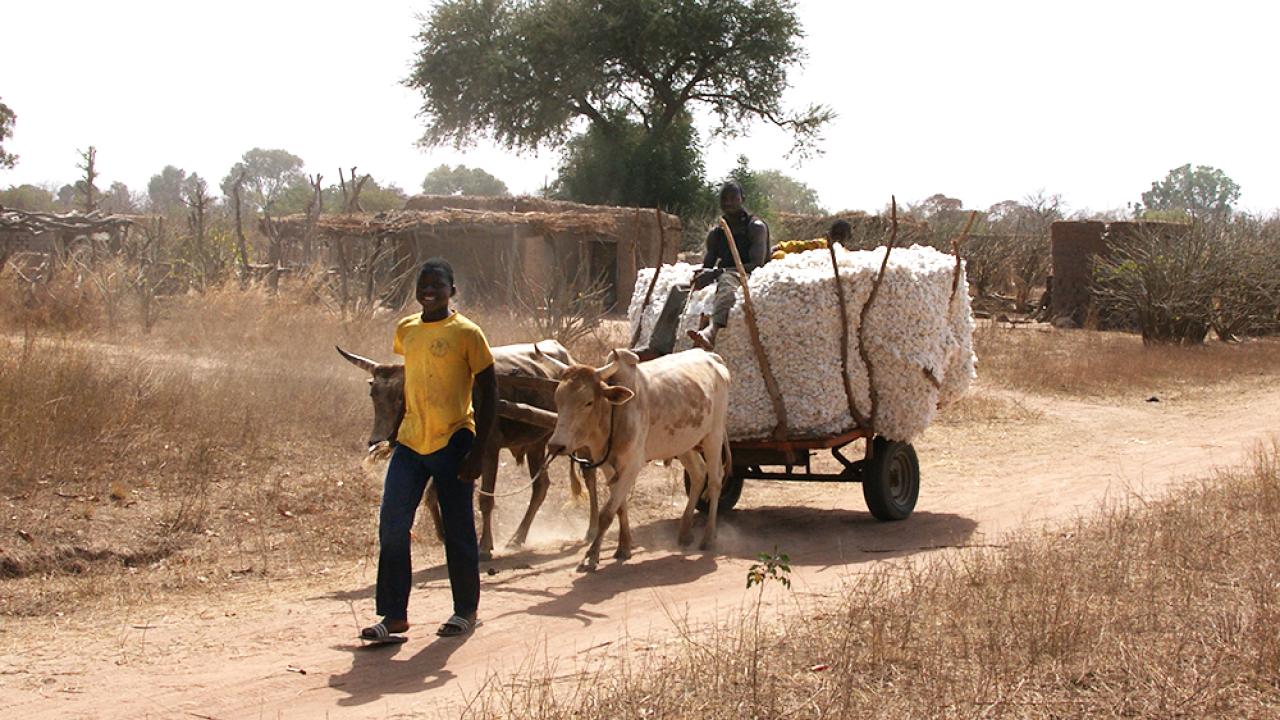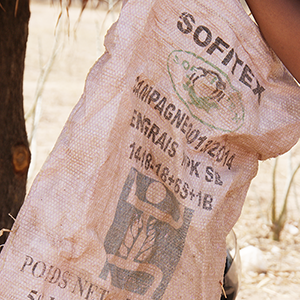
Index Insurance Has Big Returns for Small-scale Cotton Farmers and Local Economies in West Africa
When the rains are good in West Africa, cotton crops thrive. In those years, cotton farmers reap the rewards of a higher-risk cash crop and the local cotton company has more to sell. When drought strikes and cotton crops fail, farmers might have to sell off everything they own to pay back input loans. The alternative is to quit cotton entirely, a loss both for them and the local economy.
The Feed the Future AMA Innovation Lab at UC Davis has new results from pilot projects in Burkina Faso and Mali that tested how index insurance could promote resilience among cotton farmers at risk of drought. When drought struck in Burkina Faso, the insurance stepped in as a safety net, but in both countries farmers invested significantly more in their crops.
“This shows that removing risk actually helps people get to a better place,” says Michael Carter, director of the AMA Innovation Lab and a principal investigator on both projects. “The magnitude of those impacts on can be quite large.”
Agricultural Index Insurance to Promote Resilience
Both Burkina Faso and Mali occupy the western Sahel region in Africa, an area consistently at risk of severe drought. This risk often keeps farmers from investing beyond food crops that ensure subsistence for themselves and their families. If farmers do invest in more expensive but profitable cash crops like cotton or sesame, they tend to limit those investments in case a severe drought destroys everything.
Agricultural index insurance is an innovative risk-management tool for farmers who face a persistent threat of drought or other weather-related catastrophes. Index insurance avoids the high costs of verifying individual claims that makes conventional agricultural insurance too expensive to provide to small-scale farmers in developing economies.
Index insurance promotes economic development and resilience in two ways. In the event of losses, the payouts step in as a safety net. However, the larger development opportunity comes when farmers know they are protected from catastrophic loss. Research has shown that farmers who know they are insured tend to invest more in hopes of higher income in good years.
Big Impacts as Safety Net and Income Builder
The AMA Innovation Lab research team implemented pilot projects to test just how much farmers in West Africa would increase their cotton investments when protected by index insurance. The team worked with private-sector partners in Burkina Faso and Mali to develop and deliver index insurance to local farmer groups.
In Mali a coup d’état forced the project to halt in 2012, but the pilot in Burkina Faso continued through the 2014-2015 cotton season. In Burkina Faso, a drought in the 2014-15 season caused significant losses. While the insurance payouts arrived late, farmers reported that the money made a big difference.
“Since we had already sold our livestock, our cereals and other things to pay our debt, we were living in misery until the insurance payments arrived,” one farmer told the research team in 2016.
Another farmer said, “The insurance prevented us from the worst, otherwise I would have left the village.”
While the timing of insurance sales in Burkina Faso limited its impact to increases in sesame cultivation and livestock, in Mali the direct impact on cotton investments was substantial. Before the pilot was halted, farmer groups in Mali who purchased insurance increased their cotton planting by between 25-40 percent.

Based on these impacts on cotton in Mali, Carter can estimate an average cost/benefit ratio of the insurance. The total cost of insurance on the typical farm was about US $48. The resulting increase in cotton planted would at harvest increase average income by about US $300. This yields a cost/benefit ratio of 6.25. With a 50 percent subsidy for insurance premiums, for farmers that ratio jumps to 12.5.
“Those increases are massive,” says Carter. “This suggests that if you provide a better instrument to manage risk, $48 can generate $300.”
Scaling Index Insurance to Promote Broad-based Resilience
The results from Burkina Faso and Mali show that agricultural index insurance targeted to farmers can accelerate and protect growth, promoting their long-term resilience. When crops failed, the insurance stepped in as a safety net. But before that, farmers who had insurance felt secure enough to risk investing more to generate a higher income.
“Insurance can work as a safety net, but the real development opportunity comes from additional investments in productivity when farmers know they are protected,” says Carter.
Right now, the project partners in Burkina Faso are working to scale up the index insurance intervention country-wide. Tara Chiu, assistant director of the AMA Innovation Lab, says that this is an example of how agricultural index insurance can attract private-sector investment, especially in highly-integrated value chains like the West African cotton sector.
“It’s easy for people to drop out of the value chain when things go wrong,” says Chiu. “That’s why resilience isn’t just a donor or farmer problem. It’s a whole economy problem.”
Media contact:
Alex Russell, (530) 752-4798, parussell@ucdavis.edu
